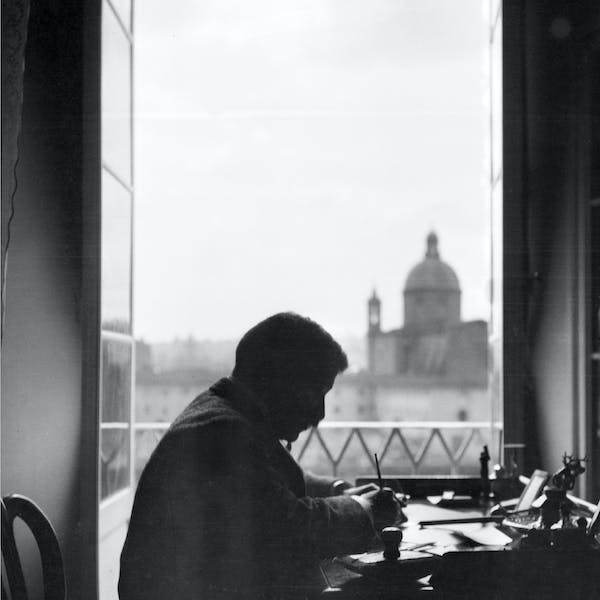Four questions about the state of Warburgian studies today
On the exhibition “Camere con vista. Aby Warburg, Firenze e il laboratorio delle immagini”, Firenze, Gallerie degli Uffizi, 19 settembre / 10 dicembre 2023
Claudia Wedepohl. Interviewed by Ada Naval
Abstract
On the occasion of the exhibition “Camere con vista. Aby Warburg, Firenze e il laboratorio delle immagini”, Firenze, Gallerie degli Uffizi, 19 settembre / 10 dicembre 2023, we present an interview with Claudia Wedepohl, director of the Warburg Archive in London, on the importance of exhibiting Mnemosyne - which is the theme that the new issue of Engramma 206 explores - and on the relevance of Warburg’s thought currently. The questions, deliberately generic, are intended to present a brief and concise response to the challenges of studying Warburg or from Warburg today. This interview was originally conducted for an article that will be published in the coming weeks for “El País”.

Aby Warburg in his room at the Hotel d’Italie. Firenze, 1906. © Warburg Institute Archive, London.
Ada Naval | After the great exhibition “The Original”, this “Camere con vista. Aby Warburg, Firenze e il laboratorio delle immagini” at the Gallerie degli Uffizi continues to claim the importance of rereading Aby Warburg’s thought, at what particular point you think Warburgian studies are now?
Claudia Wedepohl | This is difficult to say from my perspective as the Warburg Institute’s Archivist and thus the guardian of Aby Warburg’s papers. I observe an increasingly wider circulation of his writings. More texts come out in new editions. Every year we learn about the project for a new translation. This increase of availability does of course increase the study of his work, indeed well beyond my own horizon. Yet due to the many fragmented notes, drafts, letters, diaries Warburg left when he died, impossible to publish in total, much can still be found among them.
AN | A lot of research has been done on ‘how to exhibit Mnemosyne’ but in fact until “The Original” there had not been any exhibitions that recovered Mnemosyne, but there have been many exhibitions that have used Mnemosyne as a starting point. Do you believe that Warburg's panels should continue to be exhibited in order to reclaim its rigor and method rather than ‘reworking’ Mnemosyne?
CW | Warburg’s original panels have undoubtedly got an aura and that is what people are looking for in museums. Studying the Bilderatlas was and is certainly possible without the reconstruction – which, by the way is now also available through the virtual tour on our homepage. I would personally question that the panels were conceived as a kind of proto-exhibition, that Warburg was some sort of a curator. The Atlas has rightly been called a laboratory which points in the direction of your question. Warburg saw the potential for it to be developed beyond his own work. But as a Warburg scholar I’d say working with Mnemosyne requires comprehending it and that is and will remain a challenge.
AN | Could you summarise in a few words and in your opinion, what is the key point (Hauptproblem) of Aby Warburg's thought that is still most relevant today?
CW | Most relevant today I think is Warburg’s discovery of the power of images, not art, specifically in political terms. This insight let eventually to the most rigorous reform he initiated, which is the turn from Kunstgeschichte to Bildwissenschaft.
AN | How do you think the original pieces interact with the images of the panels? You have chosen the most markedly ‘florentine’ panels precisely in order to create this interplay between original and Panel, as is clear in 39, but also in 46…
CW | I would not speak of interaction but of making the Bilderatlas palpable, recreating the above-mentioned laboratory, at least partially. On his panels Warburg created series and constellations to draw out similarities, continuities and so on, across culture and time. Details are often difficult to make out on the photographs available to him. So, the visitor of the exhibition is to some extend moving back in time and enabled to study the pieces as Warburg did about a hundred years ago.
Abstract
In this interview, Claudia Wedepohl, the Archivist at the Warburg Institute and co-curator of the “Camere con vista. Aby Warburg, Firenze e il laboratorio delle immagini” exhibition at the Gallerie degli Uffizi, discusses the enduring significance of Aby Warburg’s work, particularly Mnemosyne. Wedepohl emphasizes the challenge of comprehending Mnemosyne and underscores Warburg’s discovery of the power of images in political terms as a key point still relevant today. The discussion also touches upon the idea of exhibiting Warburg's original panels to recreate the laboratory-like environment he envisioned for his work.
keywords | Warburg Institute; Gallerie degli Uffizi; Camere con vista; Bilderatlas.
Per citare questo articolo / To cite this article: C. Wedepohl, interviewied by A. Naval, Four questions about the state of Warburgian studies today. On the exhibition “Camere con vista. Aby Warburg, Firenze e il laboratorio delle immagini”, Firenze, Gallerie degli Uffizi, 19 settembre / 10 dicembre 2023, “La Rivista di Engramma” n. 206, ottobre/novembre 2023, pp. 225-227 | PDF of the article